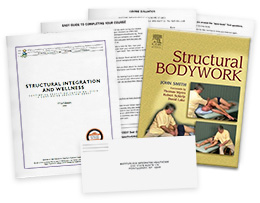14 Hour CE Course

Do you have the Structural Bodywork textbook? See your enrollment options above for "I already own the text".
This course explores the core concepts of standing and moving posture assessment. It includes topics such as functional wellness, structural integration, musculoskeletal imbalances, Feldenkrais and Rolfing. The textbook, written by Somatic Therapist John Smith, will serve as an invaluable desk reference long after the course is completed. This course does not teach hands-on skills. Please seek additional experience, with a mentor, to add hands-on skills.
| Structural Bodywork: An Overview | 0.5 hours |
| A Brief History of Structural Bodywork | 0.5 hours |
Structural Bodywork in the Context of Other Complementary Therapies What is Structural Bodywork? Structural Bodywork: Some Frequently Asked Questions |
1 hour |
Human Maps The Techniques of Structural Bodywork |
1 hour |
Structure and Function |
1 hour |
| The Connective Tissue Network | 1 hour |
The Oscillatory Properties of the Fascial Network |
0.5 hours |
| The Muscular System | 1 hour |
A Catalogue of Some Common Postural Dysfunctions |
1 hour |
| Useful Models for Working with Structure | 1.5 hours |
Assessment and Strategy in Structural Bodywork |
1 hour |
| The Sagittal Plane | 1 hour |
The Frontal and Transverse Planes |
1 hour |
Resources for Structural and Functional Bodywork Training Annotated Bibliography |
|
| Open-book Test and Course Evaluation | 1 hour |
I am very glad I opted for this course... it is what I am already trying to do instinctively so it gives me much more solid ground as well as making me want to learn more directly.Donna S, NCTMB, Las Vegas, NV
This course is one of the best I've taken so far. Clear and easy to understand. Practical. The manual is so well written that I will use it on a daily basis in my clinical practice. It will serve as my constant reference tool.Karen Moller, LMT, NCTMB
This course is definitely advanced but it was extremely helpful in explaining various approaches. The pictures were very helpful and clear, as well. This is one reference book I am very happy to have available for my use. Thanks!Lauretta Olivi, LMT
This course has given me a more in depth knowledge of what I had already learned in massage therapy school.Liz Senkbeil Sheboygan, Wis
The course was informative and the layout was easy to understand.Michael Smith, LMT
I loved this course, a lot of information to take in. It kept me very interested and I'm going to read the book again. Thank you.Debra Price, LMT, NCTMB
This course was the most thorough continuing education course I've taken. The text book was very thorough and had a plethora of helpful diagrams, charts and photos to more completely explain the material. The course was more than I hoped it would be and I will immediately incorporate what I learned into my practice.Gretta Shepherd, LMT, BCTMB
Even though I had never heard of this particular practioner/ teacher, he often referred to those with which I had personally studied. The material was a fairly clear, understandable & comprehensive overview kind of like catching up with an old friend. This is the second CEU course I've taken with your online institute in this format, and find it surprisingly engaging as well as informative.RUssell Lome
This the THE course for any manual/structural massage therapist. There is so much very important information regarding issues with the body. I certainly recommend this course wholeheartedly to any therapist who likes to help clients with stress/pain issues.Rosline Loutsios, RMT
Outstanding reference for the future! The text challenged my knowledge and I recalled learning much of the information and treatment techniques during massage school, 20+ years ago. Thank you for an excellent course!B. Kristine DeFant, LMT, BCTMB
The book was/is excellent! Loved the section showing all the techniques for specific muscular issues. Will now be a pertinent reference material in my library of resourceful books to use in my practice! Thank you!Diana Freed, LMT, BCTMB
excellent course!Francisco Torres IV, LMT
"As the muscles of inspiration release, the elastic recoil of the fascia can then be recycled, restoring the thorax to its resting state, and in the process inducing the expiration of air. This is an example of how the body can intelligently harness this stored elastic energy of the connective tissues. The same principle can be seen in the design of fusiform muscles themselves. The collagen fibers in the epimysium of muscles tend to encircle the muscle belly, running perpendicular to the long axis of the muscle. Again, a muscle actively contracts and shortens, it swells in the middle, against the elastic resistance of these fibers, which on relaxation will squeeze the muscle belly back in and assist the muscle in returning to its resting length." ( Structural Bodywork by John Smith, 2005, p. 81)
Which of the following structures have similar oscillatory properties as those of a human body?


Take our free online course: Ethics Refresher
We will not rent/sell your email to anyone.
You'll also receive our newsletter and special offers.
Thank you! An email will be sent to the address provided with instructions on how to enroll in this 1 CE hour course - FREE!
If you do not see our email within a few minutes of signing up, please check your Spam/Junk folders it may have been delivered there instead of your inbox.
If, by chance, you still have not received it within 5 minutes, please call us at 1-800-364-5722, Monday-Friday, 9am-5pm EST for assistance.